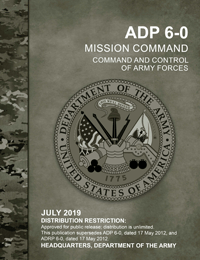Army Doctrine Reference Publication (ADRP) 6-0, Mission Command (May 2012) has been superseded by ADP 6-0, Mission Command (July 2019).
 ADP 6-0, Mission Command: Command and Control of Army Forces (July 2019), provides a discussion of the fundamentals of mission command, command and control, and the command and control warfighting function. It describes how commanders, supported by their staffs, combine the art and science of command and control to understand situations, make decisions, direct actions, and lead forces toward mission accomplishment.
ADP 6-0, Mission Command: Command and Control of Army Forces (July 2019), provides a discussion of the fundamentals of mission command, command and control, and the command and control warfighting function. It describes how commanders, supported by their staffs, combine the art and science of command and control to understand situations, make decisions, direct actions, and lead forces toward mission accomplishment.
Mission command is the Army’s approach to command and control that empowers subordinate decision making and decentralized execution appropriate to the situation. Mission command supports the Army’s operational concept of unified land operations and its emphasis on seizing, retaining, and exploiting the initiative.
The mission command approach to command and control is based on the Army’s view that war is inherently chaotic and uncertain. No plan can account for every possibility, and most plans must change rapidly during execution to account for changes in the situation. No single person is ever sufficiently informed to make every important decision, nor can a single person keep up with the number of decisions that need to be made during combat. Subordinate leaders often have a better understanding of what is happening during a battle, and are more likely to respond effectively to threats and fleeting opportunities if allowed to make decisions and act based on changing situations and unforeseen events not addressed in the initial plan in order to achieve their commander’s intent. Enemy forces may behave differently than expected, a route may become impassable, or units could consume supplies at unexpected rates. Friction and unforeseeable combinations of variables impose uncertainty in all operations and require an approach to command and control that does not attempt to impose perfect order, but rather accepts uncertainty and makes allowances for unpredictability.
ADP 6-0, Mission Command: Command and Control of Army Forces, provides a discussion of the fundamentals of mission command, command and control, and the command and control warfighting function. It describes how commanders, supported by their staffs, combine the art and science of command and control to understand situations, make decisions, direct actions, and lead forces toward mission accomplishment.
This revision to ADP 6-0 represents an evolution of mission command doctrine based upon lessons learned since 2012. The use of the term mission command to describe multiple things—the warfighting function, the system, and a philosophy—created unforeseen ambiguity. Mission command replaced command and control, but in practical application it often meant the same thing. This led to differing expectations among leadership cohorts regarding the appropriate application of mission command during operations and garrison activities. Labeling multiple things mission command unintentionally eroded the importance of mission command, which is critical to the command and control of Army forces across the range of military operations. Differentiating mission command from command and control provides clarity, allows leaders to focus on mission command in the context of the missions they execute, and aligns the Army with joint and multinational partners, all of whom use the term command and control.
Command & Control Warfighting Function
The command and control warfighting function is the related tasks and a system that enable commanders to synchronize and converge all elements of combat power (ADP 3-0). The primary purpose of the command and control warfighting function is to assist commanders in integrating the other elements of combat power to achieve objectives and accomplish missions. The command and control warfighting function consists of the command and control warfighting function tasks and the command and control system.
The command and control warfighting function tasks focus on integrating the activities of the other elements of combat power to accomplish missions. Commanders, assisted by their staffs, integrate numerous processes and activities within their headquarters and across the force through the mission command warfighting function:
• Command forces
• Control operations
• Drive the operations process
• Establish the command and control system
 This article is an extract from “BSS6: The Battle Staff SMARTbook, 6th Ed. (Plan, Prepare, Execute, & Assess Military Operations)” by The Lightning Press. Download a free PDF sample and learn more at: BSS6: The Battle Staff SMARTbook, 6th Ed. (Plan, Prepare, Execute, & Assess Military Operations).
This article is an extract from “BSS6: The Battle Staff SMARTbook, 6th Ed. (Plan, Prepare, Execute, & Assess Military Operations)” by The Lightning Press. Download a free PDF sample and learn more at: BSS6: The Battle Staff SMARTbook, 6th Ed. (Plan, Prepare, Execute, & Assess Military Operations).
Browse additional military doctrine articles in our SMARTnews Blog & Resource Center.
About The Lightning Press SMARTbooks. Recognized as a “whole of government” doctrinal reference standard by military, national security and government professionals around the world, SMARTbooks comprise a comprehensive professional library. SMARTbooks can be used as quick reference guides during operations, as study guides at education and professional development courses, and as lesson plans and checklists in support of training. Browse our collection of Military Reference SMARTbooks to learn more.y Reference SMARTbooks to learn more.














































